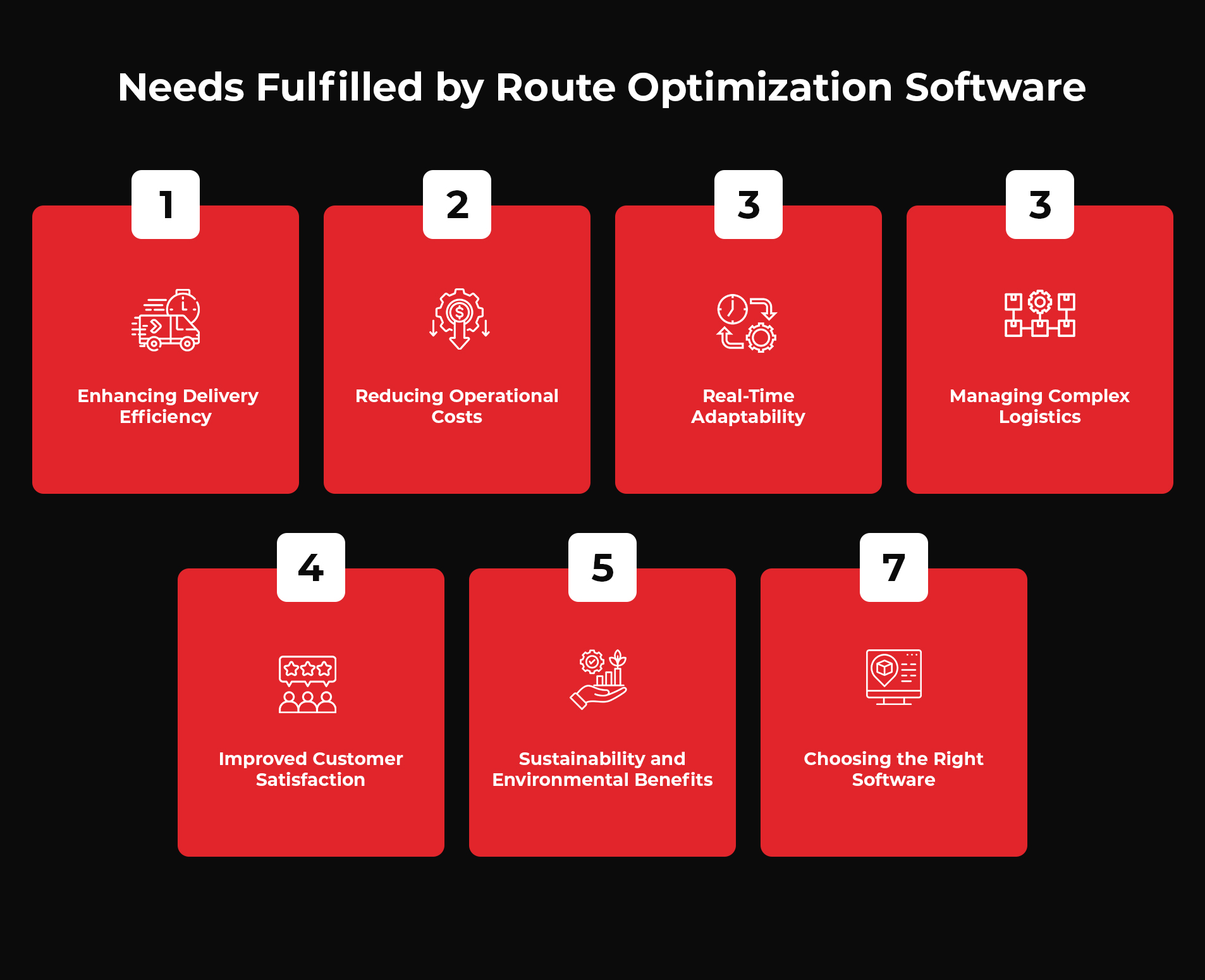In today’s fast-paced logistics landscape, businesses face mounting pressure to deliver products quickly and efficiently while minimizing costs. Whether you operate a courier service, manage a fleet, or oversee supply chain logistics, one thing is certain: route optimization software can make or break your business’s success.
This technology does more than calculate the shortest path between two points—it integrates real-time updates, minimizes fuel usage, improves delivery efficiency, and enhances customer satisfaction. Here’s why adopting route optimization software is no longer an option but a necessity for businesses aiming to stay competitive.
Needs Fulfilled by Route Optimization Software

1. Enhancing Delivery Efficiency:
Efficiency is a critical metric for logistics businesses. By employing route optimization software for delivery efficiency, companies can plan routes that reduce transit times. This can also lead to an improvement in the overall flow of operations.
Consider this: inefficient routes can increase delivery time by 15–20%, leading to higher fuel consumption, labor costs, and unsatisfied customers. The best route optimization software enables businesses to consider multiple variables, such as traffic, weather conditions, and delivery windows. This ensures efficient and timely deliveries while addressing real-world challenges.
For instance, companies using route optimization software for multiple delivery stops can improve delivery efficiency by up to 30%. This translates to faster deliveries, better resource allocation, and more satisfied clients.
2. Reducing Operational Costs:
Fuel and labor account for the largest expenses in logistics. Without efficient planning, vehicles may take longer routes, leading to wasted resources. Logistics software for route planning and optimization makes sure that every delivery vehicle runs as efficiently as possible.
For example, by choosing optimized routes, businesses can reduce fuel consumption by up to 25%. When scaled to a fleet of vehicles operating daily, this represents significant savings. Similarly, fewer idle hours mean lower labor costs, making logistics operations leaner and more profitable.
3. Real-Time Adaptability:
One of the key advantages of using the software with real-time updates is its ability to adapt to changing circumstances. In logistics, even minor disruptions such as traffic congestion or unexpected road closures can derail schedules.
Real-time updates empower businesses to dynamically reroute vehicles, ensuring deliveries stay on track. According to a survey, businesses that utilize real-time route adjustments report up to a 40% improvement in on-time delivery rates. Moreover, this adaptability reduces stress for drivers and improves overall fleet performance.
4. Managing Complex Logistics:
For businesses handling multiple delivery stops daily, manual planning is time-consuming and prone to errors. Route optimization software for multiple delivery stops excels in this situation. Automated route optimization simplifies the complexity of planning numerous stops by taking into account variables like time windows, driver schedules, and package priority. This technology streamlines the process, making it more efficient and manageable. By using this technology, companies can process up to 50% more deliveries daily compared to manual methods.
5. Improved Customer Satisfaction:
Today’s customers demand speed, transparency, and reliability. Late deliveries or poor communication can lead to negative reviews and lost business. The best route optimization software helps businesses provide accurate delivery time estimates and real-time updates, fostering trust with customers.
Additionally, features like proof of delivery (POD) and tracking notifications give customers peace of mind, further enhancing their experience. Research indicates that businesses offering real-time tracking enjoy a 23% higher customer satisfaction rate compared to those without such tools.
6. Sustainability and Environmental Benefits:
Sustainability is becoming a corporate necessity rather than merely a fad. Optimized routes reduce fuel consumption, lowering carbon emissions and supporting greener business practices.
For instance, using route planning and optimization software for logistics, a delivery fleet can cut emissions by up to 15%, aligning with corporate sustainability goals while benefiting the bottom line. This environmental advantage is especially important for businesses aiming to appeal to eco-conscious consumers.
7. Choosing the Right Software:
Not all route optimization tools are created equal. When selecting the best route optimization software, businesses should prioritize features like real-time updates, scalability, and ease of integration with existing systems. Some key features to always look for: real-time updates, integration capabilities, user-friendly interface and salability.
The Future of Logistics with Route Optimization Software
The future of logistics is being revolutionized by advancements in route optimization technology. Artificial intelligence (AI) and machine learning (ML) are transforming the way businesses predict and plan deliveries, improving accuracy and efficiency. These technologies analyze vast datasets to identify patterns, optimize routes, and reduce delays, ultimately cutting costs and enhancing customer satisfaction.
The integration of GPS and Internet of Things (IoT) devices further boosts precision. This enables real-time tracking and adjustments to routes based on traffic, weather, and other dynamic factors. Meanwhile, cloud-based systems empower businesses to scale operations seamlessly on a global level. They eliminate the need for heavy investments in physical infrastructure.
By adopting these innovations, companies can remain agile and competitive in a rapidly changing market. The convergence of these technologies is shaping a more efficient, sustainable, and responsive logistics ecosystem. Thus, ensuring businesses can meet the demands of an increasingly connected world.
Also read: Top 7 Delivery Routing and Delivery Route Optimization Software in 2024
Conclusion
In the dynamic world of logistics, staying ahead of the curve requires more than traditional methods. Route optimization software is a game-changer, offering businesses the ability to streamline operations, reduce costs, and enhance customer satisfaction. From route optimization software for multiple delivery stops to solutions with real-time updates, the right technology can transform the way businesses operate.
Incorporating these tools isn’t just a smart move—it’s an essential step toward thriving in the competitive logistics market. By investing in the best route optimization software like LogiNext, companies can future-proof their operations and secure long-term success. Click on the red button below to book a demo with LogiNext and streamline your operations.
2






















